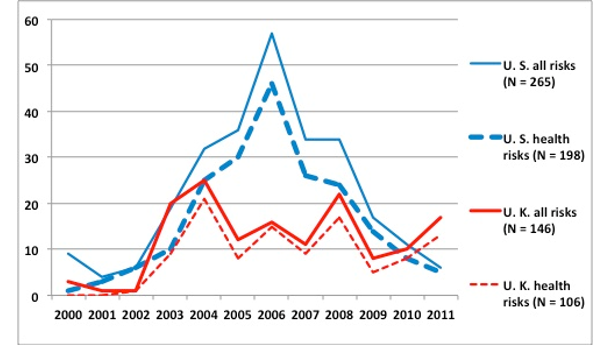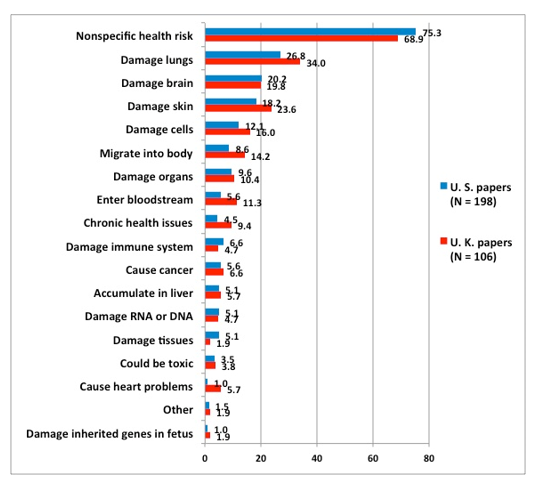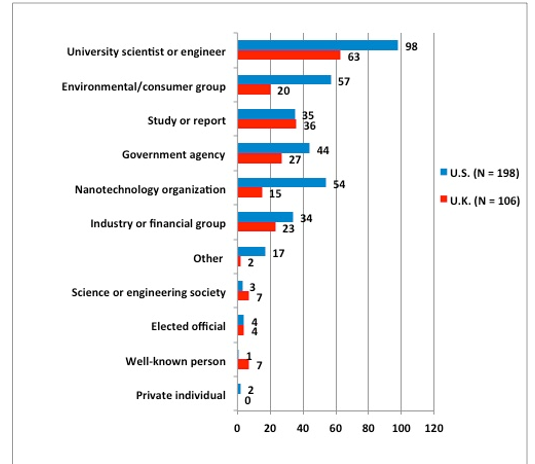Nanotechnology Health Risks: Is The Public Getting The Whole Story?
- 1. Department of Journalism and Communication, Lehigh University, USA
- 2. Center for Social Research, Lehigh University, USA
Abstract
Public distrust of scientific issues such as health risks from nanotechnology and nanomedicine can easily arise and be difficult to reverse as the recent examples of the measles vaccine and genetically modified foods have demonstrated. Most people learn about scientific issues from the mass media, yet this study found only 304 articles that discussed possible nanotechnology health risks over 12 years in 35 newspapers and two wire services in the United States and the United Kingdom. Despite this paucity of articles, the health risks were reported more frequently than nanotechnology environmental and societal risks, which were part of a larger study. Scientists were the information sources most likely to raise the nanotechnology health risk issues, and the majority of these articles were based on concerns about regulation and on studies or reports from scientific or government organizations. For two years, one online newspaper provided more extensive nanotechnology health risk coverage than did the traditional newspapers, but its coverage ended with a loss of financial support. If a public unfamiliar with nanotechnology health risks is confronted with extensive media coverage of a threatening accident or negative series of events, the situation could lead to a loss of public trust for the entire industry. Because the media are not telling the public the whole story about these possible health risks, those in the nanotechnology field are urged to develop effective strategies for communicating with the public about such risks.
Keywords
Nanotechnology , Health risks , Media coverage , Public trust and communication, Social Amplification of Risk Framework
Citation
Friedman SM, Egolf BP (2015) Nanotechnology Health Risks: Is The Public Getting The Whole Story? JSM Nanotechnol Nanomed 3(1): 1036
ABBREVIATIONS
SARF: Social Amplification of Risk Framework; NNI: National Nanotechnology Initiative; NHI: New Haven Independent newspaper
INTRODUCTION
Public understanding of and trust in nanotechnology and nanomedicine has been a concern for scientists and government officials since the technology’s early development [1]. One serious concern has been that if a major accident or series of negative events occurred, they would be reported widely by the mass media and possibly affect the entire industry. This problem could occur because risk signals such as extensive negative media coverage can amplify negative perceptions and lack of trust that would “ripple through companies, industries and other nanotechnologies,” according to the Social Amplification of Risk Framework (SARF). SARF’s thesis explains that aspects of risk events and their portrayal by the media and other sources interact with psychological, social, institutional, and cultural processes in ways that may amplify or attenuate public responses to risk events and shape public behavior [2]. Because of these concerns about media risk amplification, we tracked newspaper coverage of nanotechnology health, environmental and societal risks as part of the social science research sponsored by the National Nanotechnology Initiative (NNI) [3]. Of all the nanotechnology risks we reviewed for 12 years, health risks drew the most media attention.
This finding about health risks was not surprising because studies are increasingly announcing potential health effects from nanomaterials such as carbon nanotubes [4], nanosilver [5] and graphene [6]. In nanomedicine, there are concerns about a lack of understanding of the complex interactions between the artificial materials being developed and the biological environments in which they are placed [7]. The potential toxicity of some nanomaterials being used is also of concern [8].
Public trust and confidence in nanomaterials may depend on how well information is communicated about them — and the communication challenges are many. For example, a 2012 Harris Poll found that of 2,467 U.S. adults surveyed, 36% knew nothing about nanotechnology, 26% knew only the term, and 21% knew only a little [9]. Earlier public opinion surveys in the United States and United Kingdom had similar results [10-12]. A meta-analysis of public opinion studies found that while most of the surveyed public perceived greater benefits than risks from nanotechnology, 44% were unsure about these risks, suggesting their risk judgments were “highly malleable” [13]. Given this malleability, effectively communicating information about nanotechnology risks may prove difficult. Enhanced communication resources will be required as will improved transparency when reporting the presence of engineered nanomaterials, according to a group of nanotechnology stakeholders [14].
Enhancing communication and improving transparency means working with the mass media because they are “an integral part of the process of development of political and social opinions” [15]. Media coverage draws attention to important or salient issues and serves an agenda-setting function. Agenda-setting theory posits a strong correlation between the saliency or prominence of topics in the mass media and the weight or importance given to these issues by the audience. This prominence, for example, could come from the volume of coverage, placement of articles or types of headlines [16].
From an agenda-setting perspective, the media have focused mainly on nanotechnology’s possible positive contributions to the economy, medicine, and information technologies, according to many content analyses [17-19]. But, according to SARF, it would not take much to negatively shift that positive outlook with extensive and prominent media coverage of long-term health effects or illnesses from nanomaterials or nanotechnology products, drawing public attention to a variety of problems.
To better understand whether the media were drawing public attention to nanotechnology health risk issues, we compared coverage in U.S. and U.K. newspapers and wire services over 12 years, asking a series of research questions:
1. How many articles about nanotechnology health risks appeared and did this coverage increase over time? How did the health risk coverage compare to overall nanotechnology risk coverage?
2. What events or activities drove the coverage in the U.S. and U.K. newspapers?
3. What types of health risks prompted the most discussion in the media?
4. What groups did journalists cite as raising health risk issues and what types of journalists wrote these articles?
5. Could more nanotechnology health articles be found in an online newspaper than in traditional newspapers during a two-year period?
MATERIALS AND METHODS
We searched for articles in 23 U.S. and 12 U.K. major newspapers and the Associated Press and United Press International wire services from 2000 to 2011. The articles were culled from three databases: LexisNexis Academic, ProQuest and NewsBank The terms used for the database searches were “nanotechnology,” “risk or problem or issue or concern or toxicity or safety,” “environment or health,” “nanotechno, nanoparticl or nanometer,”“societ,” “regulat or guideline or law or oversight or policy or hazard or harm or danger.” All search terms allowed for multiple word endings, and we found more than 2,400 articles. A screening process determined whether the articles included information on nanotechnology risks or whether the search terms appeared randomly in irrelevant topics. The screening resulted in 411 relevant articles. Of these, 304 included information on health risks.
In 2010 and 2011, in light of declining nanotechnology coverage in traditional newspapers, we added a solely online newspaper, the New Haven Independent (NHI), to see whether additional nanotechnology risk information was available on the Internet. During these two years, the NHI published a regular nanotechnology section, which was sponsored by two foundation grants. In these years, the NHI published 123 nanotechnology articles including 58 about risks.
Coding and Intercoder Reliabilities
In content analysis, it is critical to make sure information in the articles is being coded systematically to ensure accurate quantitative data. For this study, information was coded on general coverage characteristics, health, environmental, societal risk and regulation data, and sources that provided information for the articles. The unit of analysis was the individual article. The majority of the codes were dichotomous, indicating presence or absence of an item. Codes for specific health risks allowed for multiple positive responses in different categories. The data were analyzed using IBM SPSS Statistics 22.
For coverage from 2000 to 2004, three coders analyzed the content of the risk articles, with an intercoder reliability of 86% overall. From 2005 to 2011, all articles were each coded by two people. After comparing responses from the two coders, the senior author arbitrated any discrepancies. Overall intercoder reliabilities were 95.8% from 2005 to 2009, and 97.9% from 2010 and 2011 for the health risk variables.
RESULTS AND DISCUSSION
Number of Nanotechnology and Health Risk Articles and Coverage Patterns
The media in the two countries exhibited different coverage patterns in number and distribution over time (Figure 1).
Figure 1: Number of U.S. and U.K risk and health risk articles.
Of the 411 nanotechnology risk articles found in traditional newspapers and wire services (collectively referred to as newspapers hereafter), 265 were in U.S. and 146 were in U.K. newspapers. U.S. articles on nanotechnology risks increased from 2002 to 2006, peaking at 57. Coverage between 2004 and 2006 and 2007 and 2008 held fairly steady between 32 and 36 articles. From 2009 to 2011, coverage decreased, with only six articles in 2011. During the same period, U.K. coverage was more erratic, with modest peaks in 2003, 2004 and 2008, resulting primarily from various newspapers reporting about the same news events. Otherwise risk coverage was low, but increased in 2010 and 2011.
Of the 304 nanotechnology health risks articles, 74.7% were in the U.S. and 72.6% were in the U.K. Health risk coverage patterns mirrored those for general nanotechnology risks in both countries (Figure 1). Despite a decrease in the U.S. health risk articles in 2010 and 2011, the majority of the articles included health risk coverage, as did the larger number in the U.K.
Factors Driving Health Risk Coverage
Discussions and actions about regulating nanosilver and carbon nanotubes because of health risks drove much of the large amount of U.S. coverage in 2006, which represented 23.2% of all U.S. health risk articles. Overall, regulatory issues were a major part of the health risk coverage, discussed in 50% of the U.S. and 55.7% of the U.K. articles. Another major factor driving the coverage were studies or reports by various scientific or governmental organizations, which were the basis for 39.4% and 37.5% of the health risks articles in the U.S. and U.K., respectively. For example, coverage of a seminal report in 2004 on nanotechnology by the Royal Society [20], highlighting various health threats, produced the highest yearly number of U.K. articles, accounting for 19.8% of its coverage.
Types of Health Risks Discussed
About 73% of the health risk articles included a reference to a nonspecific health risk, but many also included specific risks (Figure 2).
Figure 2: Percentage of specific health risks in health risk articles from 2000 to 2011.
Lungs, skin and brain risks were discussed the most. Risks to lungs appeared in 29.3% of the health risk articles, though more in U.K. than U.S. articles. Skin risks, which might come from cosmetics or sunscreens containing nanoparticles, appeared in 20.1% of the articles, with more coverage in the U.K. than in the U.S. Brain risks were discussed in 20.1% of the articles in about the same percentage in both countries. Several specific risks that might relate to nanomedicine practices followed the main three. For most of these health risks, U.K. coverage was slightly higher than in the U.S., but there were no significant statistical differences.
Sources That Raised Health Risk Issues and Types of Journalists
Scientists as a group were cited most often as raising concerns about health risks, contrary to some perceptions that environmental or consumer groups were the main “troublemakers.” Scientists were cited in 98 U.S. and 63 U.K. health risk articles (Figure 3),
Figure 3: Information sources that raised health risks in the articles.
followed by a much lower number of citations for environmental or consumer groups. Government agencies and nanotechnology and industry groups in both countries often raised health risk issues. Figure 3 also shows important differences in source use by the two countries’ newspapers. Environmental or consumer groups were the second most prominent U.S. source, followed by nanotechnology organizations. In the U.K., studies or reports were the second most popular source, followed by government agencies. Reasons behind these and other differences in source use could relate to varying newspaper styles in the two countries or the importance journalists gave to different types of sources.
Science, health or environmental reporters wrote the majority (38.4%) of the U.S. health risk articles, most of which appeared between 2004 and 2006, followed by a sharp drop in 2007. In the U.K., these reporters also wrote the majority (39.6%) of the articles, primarily in 2004, 2005, 2008 and 2010. This strong use of specialty reporters who could help explain complex scientific and technical information was invaluable for public understanding and transparency. It also resulted in long and more in-depth articles, averaging 789 words for the U.S. and 856 for the U.K. Unfortunately, many U.S. science, health and environmental reporters lost their jobs in 2007 and 2008 as newspapers significantly cut staffs because of declining advertising revenue and readership [21,22]. The decline in U.S. nanotechnology health risk articles from 2008 on is probably linked to the loss of these specialty reporters.
Online Newspaper Health Risk Coverage
Used as a comparison to the U.S. and U.K. newspapers for 2010 and 2011, the online-only New Haven Independent (NHI) showed that a considerable amount of nanotechnology health risk news was being discussed during those years, even if the traditional newspapers did not cover it. The NHI reported on health risks in 55 (94.8%) of its 58 nanotechnology risk articles. During the same two years, health risks appeared in 13 (76.5%) of 17 U.S. articles and 21 (77.8%) of 27 U.K. articles. So while the percentage of health risk articles was high for the traditional newspapers, more importantly, their two-year number of actual health risk articles was low, particularly in the U.S.,when compared to NHI coverage
In another contrast, the NHI more frequently reported on specific health risks, particularly lung risks, which appeared in 25 articles, compared to two U.S. and seven U.K. articles. And the NHI discussed health risks related to different types of nanomaterials far more often, particularly carbon nanotubes, nanosilver and titanium dioxide, than did the U.S. and U.K. newspapers. Having a dedicated journalist to write many more articles about nanotechnology health risks made a considerable difference in the amount and depth of the coverage. The drawback to NHI, however, was that its audience was small ? an average article attracted about 500 hits ?and it was usually read by people who already knew something about nanotechnology [23]. This special coverage ended when the foundation funding stopped.
CONCLUSION
This study showed that 35 traditional newspapers and two wire services in two countries provided little coverage of nanotechnology health risks from 2000 to 2011, suggesting the public was not getting the whole story about these possible health risks. Based on this study, government, science and industry representatives have rightly been concerned about a need for better strategies for communicating with the public about these issues. Even though health risks were those most frequently covered by the media, heavy positive coverage of general nanotechnology topics could leave a false impression that could create a backlash in the future. One has only to recall the blowups over vaccine inoculations and genetically modified foods to find examples of how public misunderstanding of risks can negatively affect numerous sectors of society.
The decreased number of nanotechnology health risk articles in U.S. newspapers suggests it will be unusual to find much future discussion of these risks, leaving most citizens unaware of their likelihood. The situation in the U.K. is somewhat better in that its health risk coverage actually increased in 2010 and 2011, and from 2013 to 2014, one of its major newspapers ran an online nanotechnology blog funded by a European Commission project. However, as seen with the NHI funding loss, that sponsored coverage ended too.
Curious individuals can, of course, turn to blogs and websites about nanotechnology and its potential health risks. There also continues to be a role for the mass media as indicated by a 2014 National Science Foundation survey which showed that individuals who turned to the Internet for science-related news read online editions of newspapers [24]. However, busy, disinterested people may not search for or read nanotechnology information. They would probably be unprepared if a major nanotechnology health threat were to be extensively reported, and it would probably generate anger and industry distrust, as some have feared.
Given the problems the media have in keeping people informed about nanotechnology health risks, individuals and companies working in nanotechnology may themselves have to develop the transparency and public understanding needed to avoid a backlash in the face of an amplified negative health risk issue. Consumer confidence and trust are crucial, and much of this trust will depend on how well information is disseminated. Recently seeing a major decline in public approval ratings for science [25], a number of scientific organizations have urged their members to make efforts to learn how to better communicate with the public [26, 27]. Nanoscientists and nanoengineers should also strive to enhance public communication efforts.
ACKNOWLEDGEMENTS
This research was funded from 2005-2010 under a grant from the National Science Foundation to the Harvard-UCLA Nanotechnology and Society Network, NSEC CNS SES #0531146 and by a Materials Research Science and Engineering Center grant from the Pennsylvania Department of Community and Economic Development, Contract #: C000007361. From 2011- 2014, the research was funded under a grant from the National Science Foundation to the Center for Nanotechnology in Society at the University of California at Santa Barbara, #SES-0938099.
REFERENCES
1. Roco MC. Broader social issues of nanotechnology. J of Nanoparticle Res. 2003; 5: 181-189.
6. Hu X, Zhou Q. Health and ecosystem risks of graphene. Chem Rev. 2013; 113: 3815-3835.
9. Harris Polls. Nanotechnology awareness may be low, but opinions are strong. 2012.
23. Shaw G. Interview with Friedman SM. 2013.
25. Pew Research Center. Public and scientists’ views on science and society. 2015.
26. Gross L. Toward true public engagement in science. PLOS Biologue. 2015.











































































































































